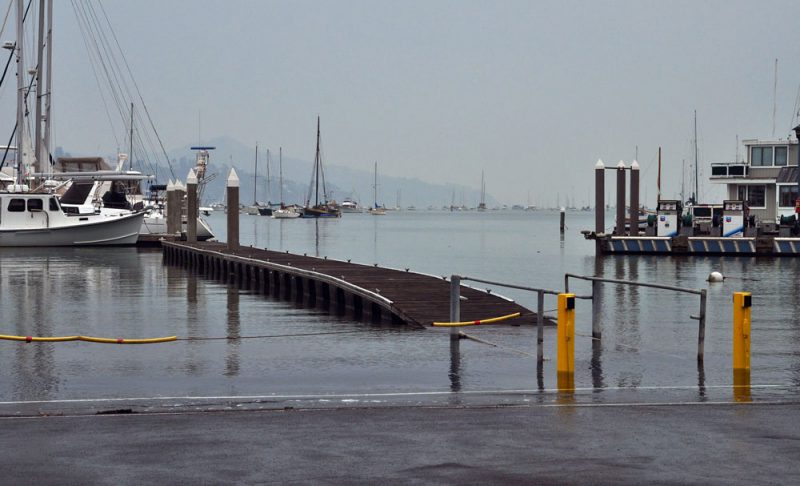
Beware the King Tides
King Tides
‘King Tides’ are coming to California on January 10-12 and February 8-9.
“Add in the runoff from winter rains and you will be walking up the gangway to your boat,” comments North Bay sailor Pat Broderick, a frequent contributor to Latitude 38. “Or wading across a low-lying parking lot. Or you can join a King Tide event. Hip boots optional.”

The California King Tides Project invites residents to “raise awareness about sea level rise and help communities plan for the future by taking and sharing photos of the highest high tides of the year. We need your help, and it’s easy to do:
- Find out what time the King Tides will be near you.
- Learn how to participate by uploading your photos via a web browser or app.
- Check out last year’s photos on our interactive map.
“During King Tides you can head out on your own, with friends and family, or join one of the organized events. As always, please be cautious and respect the power of the ocean. Learn more at california.kingtides.net.”
“Be aware that any standing water in a street in Sausalito or on Highway 101 is salty,” advises Pat. “If you don’t want your car to look like you live in Upstate New York or the Midwest, where they salt roads for ice, avoid the pools.”
If you encounter a dramatic king tide on January 10-12 at your marina or other waterfront location, snap a photo and send it off to us by email. The ‘Wolf Moon‘ will be full on January 10 — with a penumbral lunar eclipse.
‘King Tides’ aren’t exactly synonymous with ‘spring tides’. Read on to learn more.
Spring Tides
A while back, someone asked the Old Farmer’s Almanac, “Is a spring tide the same as a neap tide?”
“No,” replied the cognoscenti at the Almanac. “Spring tides usually occur twice a month at the new and full Moons, when the Sun and Moon are in a straight line with Earth. Neap tides usually occur twice a month as well, but at the first quarter and last quarter Moons, when Earth is at right angles to the Sun and Moon. Spring tides are lower- and higher-than-usual tides, whereas neap tides are in the moderate range.”
Sea Level
In the same section of that useful resource, we found a related question: “How is sea level determined? Is it the same for every sea?”
The almanac’s answer: “Sea level is determined halfway between high tide and low tide, as measured by a tide gauge. It is a relative, rather than an absolute, measurement and varies from ocean to ocean. It even varies from coast to coast on the same ocean. Sediment deposits at the mouths of rivers, natural and manmade erosion, and engineering projects can affect relative local sea level. Continental drift and global warming also may be factors. Sea level is the standard used to determine local land elevations and geographic features. Mean sea level is the average height of all the oceans and is used to determine the relative height of geographic features worldwide. According to most estimates, mean sea level has risen about four to eight inches over the past hundred years.”

I wouldn’t want to suggest that Californian boaters are tide wimps, but getting excited about a tidal swing of 7 feet? Tides in British Columbia and Washington state are fairly commonly 15 feet in the summer. Even more in Alaska and of course on the East Coast the Bay of Fundy swings over 40 feet. Your area is positively lake-like compared to what your northern comrades deal with.
Ron — Sure, we’ll give you your tides, man, which are admittedly milder at our latitude. The point of the article wasn’t about the degree of tide swing, but rather, the flooding that occurs here in the Bay as a result. With the combination of winter runoff from our wet season, as well as sea-level rise, King Tides can wreak a certain amount of havoc on our docks, piers and waterfront roads.
It’s not that we’re like, defensive or anything, but do you really want to call the Bay Area “lake-like?” We’ve heard many Pacific Northwestern sailors use the term ‘stick boating’ when referring to the high-pressure-system summers that envelope the higher latitudes and turn sailboats into motorboats. Meanwhile, down here in the Bay, it’s blowing 25 every day.
It’s not that we’re wind elitists or anything, but we do feel like we’ve paid our dues — and we’ll happily pay them again next summer. We’re sure that there’s a certain seamanship that’s bred from dealing with big tides, but we would invite you to come visit the Bay next summer, and experience the seamanship forged from our seven-month long windy season.